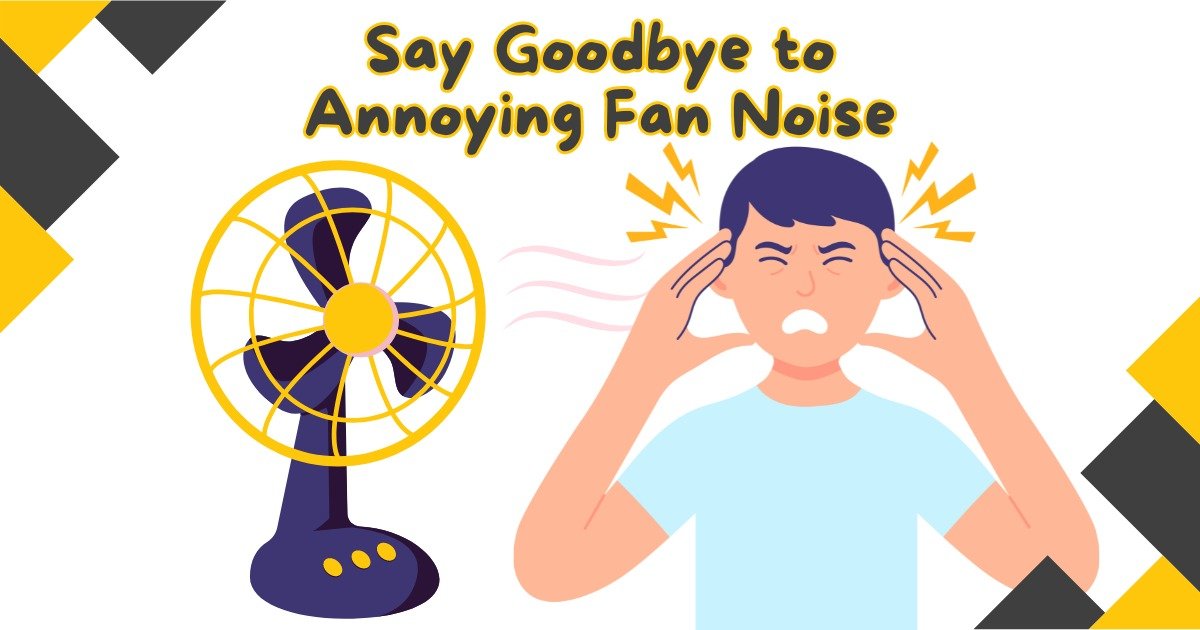Fan noise can be a nuisance, disrupting our peace and quiet, especially when we’re trying to focus or relax at home. Whether it’s the whirring of a ceiling fan or the hum of an air conditioning unit, understanding the causes of fan noise and how to mitigate it can make a significant difference in our living environment. In this blog post, we will explore the various reasons for fan noise, practical solutions to reduce it, and tips for selecting quieter fans to enhance your comfort.
What Causes Fan Noise?
The first step to addressing fan noise is understanding what causes it. Fan noise can stem from several factors, including mechanical issues that develop over time. Loose or worn-out components can lead to rattling or grinding noises. For instance, a fan blade might be out of alignment, causing it to hit the housing or other parts. Another common cause is dirt and dust buildup. When dust accumulates on fan blades, it can create an imbalance, leading to excessive noise. Regular cleaning is essential to keep the fan running smoothly and quietly.
Additionally, the design of the fan itself plays a role in the noise it produces. Different types of fans have varying levels of noise. For example, box fans tend to be noisier than ceiling fans due to their motor type and construction. Understanding the noise characteristics of various fan designs can help in choosing the right one for your needs. Airflow issues also contribute to fan noise. If a fan is obstructed or poorly positioned, airflow can become turbulent, resulting in increased noise levels. Ensuring that your fan has ample space around it can enhance its performance and reduce noise. Lastly, the age of the fan matters. Older fans may become noisier as components wear down, indicating it might be time for an upgrade.
How to Reduce Fan Noise in Your Home
Fortunately, there are several effective methods to reduce fan noise. Implementing these strategies can create a more peaceful living environment. One crucial step is to conduct regular maintenance checks on your fans. Tightening loose screws, lubricating moving parts, and cleaning dust off the blades can significantly reduce noise. Another important factor is the placement of your fan. Positioning your fan strategically can make a difference. If it’s too close to walls or furniture, airflow can be obstructed, leading to turbulence and noise. Ensuring that there is sufficient space around the fan for optimal airflow is key.
Using dampening materials is another effective way to minimize noise. Placing rubber pads under the fan can help absorb vibrations and reduce noise transmission to the surrounding structure. Additionally, when purchasing a fan, look for models specifically designed to operate quietly. Manufacturers often provide noise ratings, so choosing fans with lower decibel levels can enhance your experience. Installing a fan speed controller allows you to adjust the fan’s speed according to your needs. Lower speeds typically generate less noise, making it a practical solution for reducing fan noise.
The Importance of Choosing a Quiet Fan
Choosing a quiet fan is essential for maintaining a comfortable living environment. A quiet fan contributes to a serene atmosphere, allowing you to relax, sleep, or concentrate without distractions. Whether you’re working from home or enjoying leisure time, a quiet fan can enhance your overall comfort. For those sensitive to noise, a loud fan can disrupt sleep. Opting for a quiet fan can help create a peaceful sleeping environment, promoting better rest and recovery.
Moreover, many modern, quieter fan models are designed to be energy-efficient. They often use less energy than older, noisier models, leading to cost savings on your energy bills while contributing to a more sustainable lifestyle. Therefore, the benefits of choosing a quiet fan extend beyond just noise reduction; they also enhance your comfort and contribute to energy savings.
DIY Methods to Fix Noisy Fans
If you’re experiencing noise issues with your fan, there are several DIY methods you can try before considering a replacement. These simple fixes can often resolve common problems. Start by tightening screws and bolts. Over time, screws and bolts can become loose, leading to vibrations and noise. Check all screws on the fan housing and blades, and tighten them as necessary. Cleaning the blades is also crucial. Dust and debris can cause imbalances, resulting in noise. Use a soft cloth and a mild cleaner to gently wipe down the fan blades and remove any buildup.
Another effective method is lubricating the motor. If your fan has a motor that can be lubricated, applying a few drops of machine oil can keep it running smoothly. This helps reduce friction and noise. If you notice that one blade appears to be bent or damaged, it may be causing noise. Check the blades for damage and replace any that are out of alignment to ensure they are balanced. Lastly, if your fan is older, some parts may be worn out. Check for any frayed wires or damaged components and replace them if necessary.
Types of Fans and Their Noise Levels
Understanding the types of fans available and their associated noise levels can help you make informed choices. Ceiling fans are generally designed to operate quietly, making them suitable for bedrooms and living areas. Look for models with DC motors, as they tend to be quieter than traditional AC motors. Box fans, while effective for cooling, can be noisier than other types. However, some brands offer quieter models, so be sure to check reviews for noise levels. Tower fans are typically quieter than box fans and can provide effective cooling with minimal noise, making them a popular choice for those seeking a discreet cooling solution.
Exhaust fans are often installed in bathrooms or kitchens to remove moisture and odors. While necessary, they can be loud. Look for models with noise ratings that suit your preferences. Portable fans can vary widely in noise levels. When shopping for a portable fan, check for noise specifications and choose a model that suits your noise tolerance.
Troubleshooting Fan Noise: When to Seek Help
While many fan noise issues can be resolved with DIY methods, there are specific circumstances where seeking professional help becomes necessary. If you have diligently tried various fixes—like tightening screws, cleaning the blades, or lubricating the motor—and the noise persists, this may indicate a more serious mechanical issue that requires expert attention. Strange noises, such as grinding or rattling, can signal a malfunctioning motor or a failure in another critical component. Ignoring these sounds could lead to more significant problems down the line, potentially resulting in costly repairs or safety hazards.
Additionally, if you notice flickering lights or any other electrical issues associated with your fan, it is crucial to consult a qualified electrician. These electrical anomalies may point to wiring problems or other safety concerns that require immediate action. Lastly, if your fan is frequently breaking down or demands constant repairs, it may be more cost-effective to replace it rather than continue investing in repairs. Replacing a worn-out fan with a newer, more efficient model can save you money in the long run while providing a quieter and more reliable cooling solution.
Top Quiet Fans for 2024
When selecting a fan, consider some top quiet fan models that are highly rated for their performance and low noise levels. The Dyson Cool AM07 is a bladeless fan that operates quietly and is perfect for bedrooms or offices. It features a sleek design and easy-to-use remote control. The Honeywell QuietSet series offers several speed settings, allowing you to customize the airflow while maintaining a quiet operation. The Vornado 630 is known for its powerful airflow and quiet performance, circulating air efficiently while minimizing noise.
The Lasko 2510 is a tower fan that provides quiet cooling, making it perfect for smaller spaces. Finally, the Bionaire Silent Oscillating Tower Fan is designed for whisper-quiet operation, ideal for bedrooms and living areas.
Conclusion: Achieving Peaceful Living with Quiet Fans
In conclusion, understanding fan noise and its causes is essential for creating a peaceful living environment. By implementing regular maintenance, choosing the right location, and selecting quieter models, you can significantly reduce noise levels in your home. Whether you opt for DIY solutions or invest in a new fan, achieving a comfortable and quiet atmosphere is within reach. With the right approach, you can enjoy the benefits of effective air circulation without the accompanying noise.
FAQs about Fan Noise
FAQs About Fan Noise
Why is my fan making a rattling noise?
A rattling noise from your fan is usually caused by loose screws or components. To fix this, check and tighten any loose parts securely.
How should I clean my fan?
To clean your fan, first disconnect it from power. Use a soft cloth and a mild cleaner to wipe down the blades and housing. Regular cleaning helps maintain performance and reduces noise.
Which type of fan is the quietest?
Bladeless fans, such as those from Dyson, are often the quietest due to their innovative design, which minimizes the noise created by traditional blades.
Can I repair a noisy fan?
Yes, many fan noise issues can be resolved with simple maintenance, such as tightening parts or cleaning. However, if the problem persists, you may need professional assistance.
How often should I clean my fan?
It’s recommended to clean your fan at least once a month to prevent dust buildup and ensure smooth, quiet operation.










